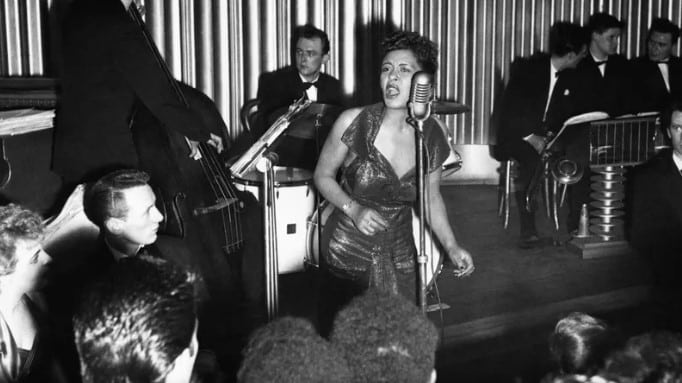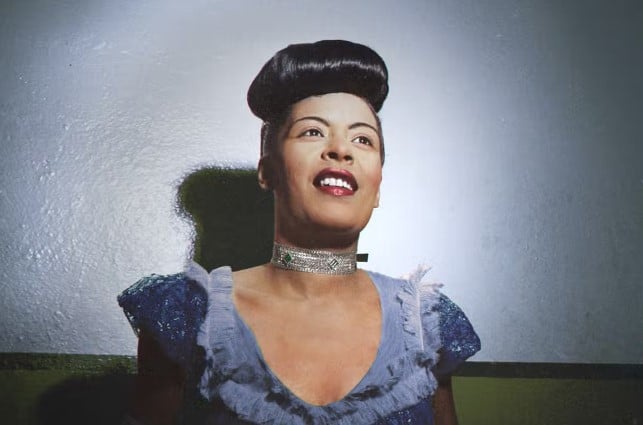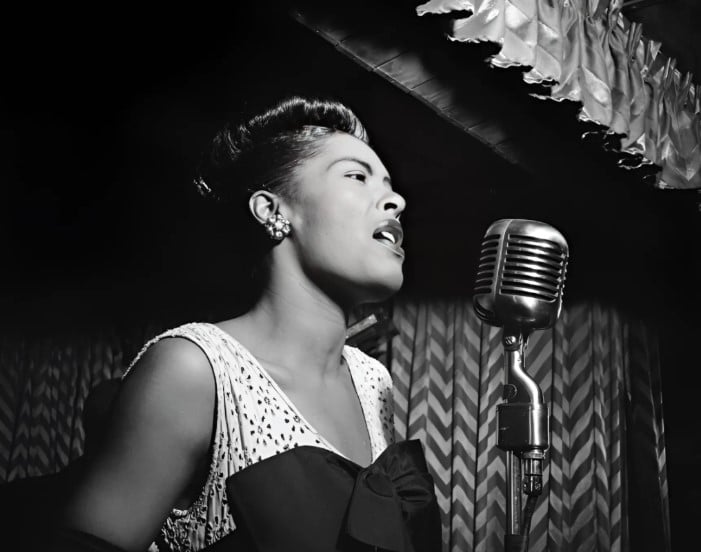Most artists belong to their times, but the music of Billie Holiday, born more than 100 years ago, seems timeless, resonating with contemporary audiences. She tragically passed away just as the nation began confronting pressing issues such as race, drugs, feminism, and misogyny – all of which converged in her life. Until her music and experiences remain poignant reminders of the struggles and complexities of American society.
Billie Holiday’s Childhood: Overcoming Adversity And Finding Solace In Song

Billie Holiday was born in 1915 to unwed teenage parents. Her mother was just thirteen, and her father was fifteen. Her father, who was a musician, left when she was young, and her mother often had to travel for work, leaving Billie in the care of relatives. During her young life, she lived with her mother in Baltimore.
Due to her mother’s “transportation jobs”, Billie stayed with her older half-sister, Eva Miller, who was married. Billie was mostly raised by Eva’s mother-in-law, Martha Miller, and had a tough upbringing.
Holiday started kindergarten at St. Frances Academy, where she frequently skipped school. She got in trouble with the juvenile court at just 9 years old. As a result, she was sent to the House of the Good Shepherd, a Catholic reform school for African-American girls. She spent nine months there before being “paroled” on October 3, 1925, and sent back to her mother, Sadie. Together, they worked long hours at Sadie’s restaurant, the East Side Grill. At the age of 11, she dropped out of school.

Sadly, at the same age, she experienced a traumatic event: she was raped by a neighbor. Then, she was placed in the House of the Good Shepherd under protective custody as a state witness for the rape case. She was finally released in February 1927, when she was almost 12 years old.
She found a job running errands at a brothel, and she also worked hard cleaning marble steps, kitchens, and bathrooms in the neighborhood. It was during this time that she first discovered the music of Louis Armstrong and Bessie Smith through their records.
“When it came time to pay me, I used to tell her she could keep the money if she’d let me come up in her front parlor and listen to Louis Armstrong and Bessie Smith on her victrola. A victrola was a big deal in those days, and there weren’t any parlors around that had one except Alice’s. I spent many a wonderful hour there listening to Pops and Bessie.”
Instead of taking money for her work, she asked to listen to Louis Armstrong and Bessie Smith on the victrola. Through all these experiences, Billie was in love with music and singing. “I used to love to sing all the time,” she would say.
Rise to Fame: From Harlem Nightclubs To Recording Stardom

By early 1929, Holiday moved to Harlem to be with her mother. She began singing in nightclubs. The young singer teamed up with saxophone player Kenneth Hollan. Together, they performed at various clubs like the Grey Dawn, Pod’s and Jerry’s, and the Brooklyn Elks Club until 1931. As her fame grew, she sang at more clubs, including Mexico’s and the Alhambra Bar and Grill, where she met vocalist Charles Linton.
Producer John Hammond first heard Holiday there in early 1933 and arranged for her recording debut at just 18 years old. She recorded two songs: “Your Mother’s Son-In-Law” and “Riffin’ the Scotch,” with the latter becoming her first hit, selling 5,000 copies after its release on November 11.
Hammond was impressed by Holiday’s singing style and said of her, “Her singing almost changed my music tastes and my musical life, because she was the first girl singer I’d come across who actually sang like an improvising jazz genius.”
The Stories Behind Her Iconic Songs
Singing was like magic for Holiday, a way to connect and express herself deeply. “If I had to sing ‘Doggie in the Window,’ that would actually be work,” she writes. “But singing songs like ‘The Man I Love’ or ‘Porgy’ is no more work than sitting down and eating Chinese roast duck, and I love roast duck.”

Many of her most famous songs came from moments in her life, both traumatic and trivial. For example, when her father Clarence, a musician who lived large, died in 1937 while traveling due to racial discrimination. “It wasn’t the pneumonia that killed him, it was Dallas, Texas. That’s where he was and where he walked around, going from hospital to hospital trying to get help. But none of them would even so much as take his temperature.”
Out of this pain came “Strange Fruit,” a song about a lynching in the South, which held a deeply personal meaning for her. “I have to keep singing it,” she writes, “not only because people ask for it, but because twenty years after Pop died, the things that killed him are still happening in the South.”
Another hit, “God Bless the Child,” started as a joke to tease her mom after she refused to lend her money. “She wouldn’t give me a cent. She was mad with me and I was mad with her,” Holiday writes. “We exchanged a few words. Then I said, ‘God bless the child that’s got his own,’ and walked out. I stayed sore for three weeks.”
When her first husband, Jimmy Monroe, cheated on her, it inspired the heartbreaking ballad “Don’t Explain.” “One night he came in with lipstick on his collar,” she writes. “I saw the lipstick. He saw I saw it, and he started explaining and explaining…Lying to me was worse than anything he could have done with any bitch. I cut him off, just like that. ‘Take a bath, man,’ I said, ‘don’t explain.’”
How She Faced Racism

In late 1937, Holiday had a brief stint as a big-band vocalist with Count Basie.
“I joined Count Basie’s band to make a little money and see the world. For almost two years I didn’t see anything but the inside of a Blue Goose bus,” Holiday writes of her time touring with the famous orchestra. “Nobody bothered to tell me I’d have to travel 500 to 600 miles on a hot or cold raggedy-ass…bus; that it would cost me two or three bucks a night for a room; that by the time I was through having my hair fixed and gowns pressed…I’d end up with about a dollar and a half a day.”
Holiday and the band worked hard rough dance halls, hotels, and various low-quality venues across the country. They faced constant racism, such as when the management at the Fox Theater in Detroit demanded that she darken her face before she could sing with the all-Black band. The orchestra couldn’t afford sheet music, so they memorized over 100 songs, often going to bed hungry despite their seemingly glamorous profession.
“You can be up to your boobies in white satin, with gardenias in your hair and no sugar cane for miles, but you can still be working on a plantation,” Holiday notes wryly.

By February 1938, Billie Holiday had stopped singing for Count Basie’s band. All Music Guide says she got fired for being “temperamental and unreliable,” while Holiday complained about low pay and bad working conditions. She might have refused to sing certain songs or change her style.
Holiday then got a job with Artie Shaw, a brilliant and controversial bandleader. She became one of the first Black women to sing with an all-white band. Whenever Holiday faced racism, Shaw stood up for her. In her autobiography, Holiday talks about a time when she wasn’t allowed to sit on the bandstand with other singers because of racist rules. Shaw said to her, “I want you on the band stand like Helen Forrest, Tony Pastor and everyone else.”
During her tours in the South, Holiday would sometimes face heckling from the audience. In Louisville, Kentucky, a man called her a “nigger wench” and demanded she sing another song. This made Holiday lose her temper, and she had to be escorted off the stage.
One night, while performing at Café Society in the San Fernando Valley, Holiday faced harassment from a white audience member during her first two shows. It made her consider quitting altogether. “I knew if I didn’t, the third time round I might bounce something off that cracker and land in some San Fernando ranch-type jail.”
Bob Hope came up to her with Judy Garland and the comedian Jerry Colonna. “You go out there and sing,” he told Holiday. “Let that sonofabitch say something and I’ll take care of him.” When the heckler began hurling abuse, Hope was ready. “Hope traded insults with that cracker for five minutes before he had enough and left,” Holiday writes.
Struggles With Drug And Alcohol Addiction

“I spent the rest of the war on 52nd Street and a few other streets. I had the white gowns and the white shoes. And every night they’d bring me the white gardenias and the white junk,” Holiday writes of her years during World War II. By the early 1940s, addicted to heroin. She tried to get clean for the first time in 1946, but news of her stay in a sanitarium was leaked. Soon after, she found herself under constant surveillance by federal agents, who were eager to catch her with drugs.
“Trouble is a thing I’ve learned to smell,” Holiday writes. The singer knew what was coming after closing a run at Philadelphia’s Earle Theater in 1947. As she returned to her hotel, she noticed police officers swarming the lobby, ready to approach her limo. Quick on her feet, Holiday took decisive action to avoid any trouble.
When Billie Holiday got sick and ended up alone, she had to admit to having drugs. She talks about her trial, saying it felt like it was her against the whole country. She was sent to Alderson Federal Prison Camp in West Virginia, but she didn’t get any help for her drug addiction, even though she really needed it.
While she was in prison, Billie spent her time knitting, making whiskey out of potato peels, and taking care of a bunch of noisy pigs. But one thing she didn’t do was sing. She explains that she couldn’t sing unless she felt something, and during her time in prison, she didn’t feel anything at all.
A Heartbreaking Conclusion of Billie Holiday’s Life

In early 1959, Billie Holiday was diagnosed with cirrhosis of the liver, a serious condition often caused by heavy drinking. Despite her doctor’s orders to stop, she struggled with alcoholism and eventually relapsed. On May 31, 1959, she was admitted to Metropolitan Hospital in New York for treatment of both liver and heart disease.
During her final years, Holiday faced financial troubles as her husband, McKay, swindled her out of her earnings. She died with US$0.70 in the bank ($7.40 in 2023). Her funeral Mass took place on July 21, 1959, at the Church of St. Paul the Apostle in Manhattan.
Gilbert Millstein, a writer for The New York Times who knew Holiday well, described her passing in the sleeve notes of her album “The Essential Billie Holiday.”
“Billie Holiday died in Metropolitan Hospital, New York, on Friday, July 17, 1959, in the bed in which she had been arrested for illegal possession of narcotics a little more than a month before, as she lay mortally ill; in the room from which a police guard had been removed – by court order – only a few hours before her death. She had been strikingly beautiful, but her talent was wasted…”

